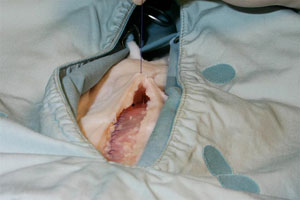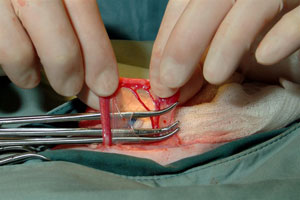1. Where should the incision be placed to perform an ovariohysterectomy in a cat?

a. between the xiphoid and the pubis
b. between the xiphoid and the umbilicus
c. between the umbilicus and the pubis
d. middle third of distance between umbilicus and pubis
d. middle third of distance between umbilicus and pubis
How is this incision modified to perform a complete exploratory laparotomy at the same time as an ovariohysterectomy?
a. incision should extend cranially to the xiphoid
b. incision should extend caudally to the pubis
c. both a and b
d. no adjustment is needed as all the structures can be visualized through a spay incision
c. both a and b
3. Why should excessive subcutaneous dissection be avoided when incising the subcutaneous tissue?

b. this can damage the blood supply to the abdominal wall leading to delayed healing and herniation
c. this creates excessive dead space that can result in seroma formation in the postoperative period
d. this predisposes the animal to fat necrosis and postoperative infections
c. this creates excessive dead space that can result in seroma formation in the postoperative period
4. In this PDF, what is the labelled structure?
a. duodenocolic ligamentb. right suspensory ligament
c. left suspensory ligament
d. triangular ligament
a. duodenocolic ligament
5. In this PDF, what is the labelled structure?
a. mesenteric lymph nodesb. ileocecal lymph nodes
c. colonic lymph nodes
d. internal iliac lymph nodes
b. ileocecal lymph nodes
6. In this PDF, what is the labelled structure?
a. right medial liver lobeb. right lateral liver lobe
c. caudate lobe
d. quadrate lobe
c. caudate lobe
7. In this PDF, what is the labelled structure?
a. left ovarian veinb. splenic vein
c. left renal vein
d. left phrenicoadbdominal vein
d. left phrenicoadbdominal vein
8. What is the purpose behind the middle clamp placed on the ovarian pedicle during the 3 clamp procedure?

b. to keep the ovarian pedicle from retracting into the abdomen
c. to keep the ovary out of the ligature
d. to facilitate cutting and allow controlled release of the pedicle
d. to facilitate cutting and allow controlled release of the pedicle
9. If hemorrhage is occuring from the left ovarian pedicle, what structure can you use to help you visualize the pedicle quickly?
a. greater omentum
b. mesocolon
c. mesoduodenum
d. mesojejunum
b. mesocolon
10. Which of the following is NOT likely to result in damage to the ureter during an ovariohysterectomy?
a. tearing of the suspensory ligament inside the abdomen
b. placement of clamps on the ovarian pedicle without exteriorizing the ovary>
c. clamping just caudal to kidney while attempting to deal with hemorrhage from a loose ligature on the ovarian pedicle
d. clamping the uterine body in the abdomen because the incision is to cranial to bring it out of the abdomen
a. tearing of the suspensory ligament inside the abdomen
11. What are the 2 most common reasons why inexperienced surgeons have an increased rate of postsurgical hernias?
a.failure to take a big enough bite of the peritoneum during abdominal wall closure
b. failure to take a big enough bite of the rectus muscle during abdominal wall closure
c. failure to take a big enough bite of the external rectus fascia during abdominal wall closure
d. failure to tie secure knots
e. using a simple continuous suture pattern to close the abdominal wall
c. failure to take a big enough bite of the external rectus fascia during abdominal wall closure
d. failure to tie secure knots

